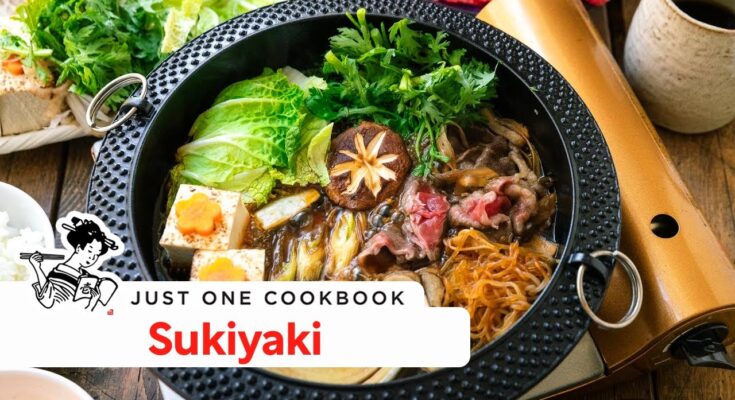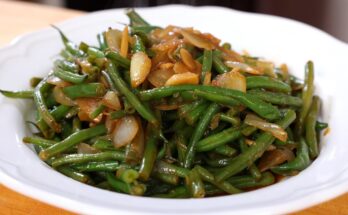Sukiyaki Recipe: Sukiyaki is one of Japan’s most beloved hot pot dishes. Known for its sweet-savory flavor profile and communal dining style, it’s a dish that brings people together. Sukiyaki features thinly sliced beef simmered in a soy-based sauce with vegetables, tofu, and noodles, all cooked at the table. Unlike Western stews, where ingredients are mixed and simmered for long periods, sukiyaki emphasizes balance—both in taste and presentation. The dish is traditionally enjoyed by dipping the hot ingredients in raw beaten egg before eating, creating a silky, rich flavor layer.
Origin and Cultural Significance
Sukiyaki originated during the Meiji era (late 19th century), a time when Japan was opening up to Western influences. Before this era, beef consumption was rare due to Buddhist dietary customs. Sukiyaki marked a cultural shift, quickly becoming a popular way to enjoy beef. Today, it’s synonymous with celebration—served during special occasions like year-end parties or family gatherings. More than a meal, sukiyaki is an experience, a warm, interactive dish perfect for cold seasons and meaningful moments.
Ingredients Needed for Sukiyaki
Core Ingredients
To make an authentic sukiyaki, gather these essentials:
- Beef (thinly sliced ribeye or sirloin)
- Tofu (firm or grilled)
- Shirataki noodles (konjac noodles)
- Napa cabbage
- Shungiku (edible chrysanthemum leaves)
- Green onions (scallions or negi)
- Shiitake mushrooms or enoki mushrooms
- Carrot slices (for color and sweetness)
These ingredients form the base of any sukiyaki dish. What makes this dish so appealing is how it combines flavors and textures—from the tender meat to the chewy noodles and crisp vegetables.
Optional Add-Ons
Want to get creative? Consider these optional ingredients to personalize your sukiyaki:
- Udon noodles – added at the end to soak up the sauce
- Eggs – for dipping (raw, well-beaten)
- Leeks or daikon radish – for an earthy touch
- Kamaboko (fish cake) – for a bit of seafood essence
- Rice – served on the side
It’s okay to substitute or add ingredients based on availability or preference. Just ensure you keep the balance of sweet, salty, and umami in check.
Choosing the Right Meat for Sukiyaki
Beef Cuts Ideal for Sukiyaki
The heart of sukiyaki is beef—thin, tender, and marbled. The most recommended cuts include:
- Ribeye – offers a good balance of marbling and flavor
- Sirloin – leaner but still tender
- Chuck eye roll – more budget-friendly with decent fat content
- Wagyu – the gold standard for sukiyaki; rich and melt-in-your-mouth
The beef should be sliced paper-thin. You can often find “sukiyaki beef” pre-sliced in Asian supermarkets. If slicing at home, freeze the meat for about 30 minutes beforehand—it makes thin slicing much easier.
Tips on Meat Preparation
- Always cut against the grain for tenderness.
- Pat the slices dry to prevent excess moisture.
- Arrange beef slices neatly for visual appeal and even cooking.
- For vegetarian sukiyaki, replace beef with thick slices of shiitake mushrooms or tofu steak.
Proper beef preparation is crucial; it determines not just the taste but also how well the meat interacts with the sauce and vegetables.
How to Make Sukiyaki Sauce (Warishita)
Ingredients for Warishita
Warishita is the lifeblood of sukiyaki, a delicate mixture of:
- 1/2 cup soy sauce
- 1/2 cup mirin (sweet rice wine)
- 1/4 cup sake
- 1/4 cup sugar
- Optional: a splash of dashi stock for umami
Simply mix the ingredients and heat gently until the sugar dissolves. It’s important not to boil the sauce, as high heat can alter the flavor profile.
Balancing the Flavors
The secret to a perfect warishita is balance:
- Too salty? Add a bit more mirin or sugar.
- Too sweet? Add a dash more soy sauce or sake.
- Lacking umami? A small amount of dashi or mushroom extract can help.
Make a test batch if it’s your first time—taste it with a spoon and imagine it coating beef and tofu. Adjust until it feels just right.
Step-by-Step Sukiyaki Cooking Instructions
Preparing the Ingredients
Preparation is key to a seamless sukiyaki experience. Here’s what to do before you light the stove:
- Slice the beef and vegetables thinly – uniform pieces cook evenly.
- Drain shirataki noodles – rinse well to remove odor.
- Cut tofu into cubes – pat dry to prevent splattering.
- Arrange everything on a platter – presentation matters.
Organizing ingredients beforehand turns cooking into a smooth, enjoyable activity, especially when sharing the dish with guests.
Cooking Sukiyaki the Traditional Way
You don’t need a fancy hot pot—any wide, shallow pan will do. Follow these steps:
- Heat a lightly greased pan – traditionally, a beef tallow piece is used.
- Add a few slices of beef and sear briefly.
- Pour in a bit of warishita sauce to flavor the meat.
- Add vegetables, tofu, and noodles in separate sections of the pan.
- Simmer gently and add more sauce as needed.
Let everyone serve themselves straight from the pot. Dip cooked items in raw beaten egg (optional but highly recommended) before eating.
When most of the ingredients are finished, add udon noodles to absorb the remaining sauce for a satisfying finish.
Tips for the Best Sukiyaki Experience
Create a Cozy Dining Setup
Sukiyaki is more than just food—it’s about the experience. Make it special by setting up a cozy table with:
- A portable stove or induction cooker at the center
- Small bowls for dipping sauce and egg
- Plenty of napkins and chopsticks
- A communal vibe where everyone can take part in the cooking
This kind of setup encourages interaction, sharing, and fun conversation. It’s the perfect meal for an intimate gathering or a festive celebration.
Cook in Batches for Freshness
Don’t throw everything into the pot at once. Sukiyaki is best cooked in small batches, so:
- Ingredients stay fresh and flavorful
- You can control cooking times better
- Each serving gets a fresh dose of warm sauce and beef
Start with a layer of beef and a few veggies, and once those are eaten, cook the next batch. This also keeps the pot clean and prevents overcooking.
Health Benefits of Sukiyaki
Nutritional Value of Ingredients
Sukiyaki isn’t just tasty—it’s packed with nutrients. Here’s what you get:
- Beef – high-quality protein, iron, and vitamin B12
- Tofu – plant-based protein and calcium
- Vegetables – vitamins, fiber, and antioxidants
- Shirataki noodles – low-carb, low-calorie, and gut-friendly
This balance of macronutrients and micronutrients makes sukiyaki a wholesome meal, especially when eaten in moderation.
Low Carb and Keto Adaptations
If you’re watching carbs, consider these tweaks:
- Use zucchini noodles or extra mushrooms instead of shirataki
- Go light on mirin and sugar in the sauce (use erythritol or monk fruit)
- Skip dipping rice or udon at the end
This way, you can enjoy the comforting depth of sukiyaki while keeping your meal aligned with your health goals.
Sukiyaki vs Shabu Shabu: What’s the Difference?
Cooking Style Comparison
Though they may look similar, sukiyaki and shabu shabu are quite different:
- Sukiyaki involves cooking ingredients in a sweet soy-based sauce.
- Shabu shabu uses a light dashi broth, and meat is swished briefly to cook.
Both are “hot pot” styles, but sukiyaki is richer and more indulgent, while shabu shabu is lighter and more subtle.
Taste and Texture Differences
Sukiyaki has a strong, savory-sweet flavor and often results in more caramelized ingredients. Shabu shabu is more delicate and highlights the natural flavor of each ingredient. It all comes down to preference: want bold? Go sukiyaki. Want clean and simple? Choose shabu shabu.
Regional Variations of Sukiyaki in Japan
Kanto vs Kansai Style
Japan has two major styles of sukiyaki:
- Kanto (Tokyo) Style: Ingredients are simmered in warishita from the beginning.
- Kansai (Osaka) Style: Beef is seared first, then seasonings are added individually.
Kanto’s method is easier for beginners, while Kansai-style sukiyaki is considered more traditional and elegant. Both styles are delicious—it just depends on which flavor profile you prefer.
Modern Twists on Traditional Sukiyaki
Modern chefs and home cooks often add unique spins to sukiyaki, such as:
- Using duck or chicken instead of beef
- Adding cheese or truffle oil for fusion versions
- Using instant sukiyaki sauce for quick meals
- Making vegan sukiyaki with tempeh, mushrooms, and vegetable broth
These variations maintain the essence of the dish while adapting to modern tastes and dietary needs.
How to Store and Reheat Leftover Sukiyaki
Storage Tips
Have leftovers? Here’s how to store them properly:
- Let everything cool completely before storing
- Place leftovers in an airtight container
- Store in the fridge for up to 3 days
Avoid mixing all the leftovers together—keep meat separate from noodles if possible. This helps maintain texture and flavor when reheated.
Reheating Without Losing Flavor
To reheat:
- Place the leftovers in a pan
- Add a splash of water or leftover sauce
- Heat gently on low until warm
Microwaving is an option, but reheating on the stove preserves the taste and texture better. Avoid boiling, as it can make the meat tough and veggies mushy.
Serving Suggestions for Sukiyaki
Best Side Dishes
Pair your sukiyaki with sides that complement its rich flavors. Try:
- Steamed white rice
- Pickled vegetables (tsukemono)
- Miso soup
- Japanese potato salad
- Cold soba noodles (for a refreshing contrast)
These side dishes balance the umami of sukiyaki and make for a more complete meal.
Drinks That Pair Well
As for drinks, you can’t go wrong with:
- Green tea – classic and cleansing
- Sake – traditional and festive
- Cold beer – a popular match in izakayas
- Sparkling water – refreshes the palate
Keep it light and refreshing to balance the depth of the sukiyaki sauce.
Hosting a Sukiyaki Party: Entertain the Japanese Way
Planning the Menu and Setup
Hosting a sukiyaki night? You’re in for a treat—and so are your guests. Here’s how to plan a smooth and fun sukiyaki dinner:
- Decide on the sukiyaki style (Kanto or Kansai)
- Prepare all ingredients in advance—sliced, chopped, and ready to cook
- Set up a hot pot at the center of the table
- Provide dipping bowls and chopsticks for each guest
- Include a variety of veggies and proteins to cater to all dietary needs
Make sure to have extra sauce and optional toppings like sesame seeds, chili flakes, or ponzu for guests who want to mix it up.
Interactive Dining Experience
A sukiyaki party is not just about food—it’s about interaction. Your guests get to:
- Cook their own food in the hot pot
- Customize their flavors by adjusting sauces and dips
- Share stories and laughs while gathering around the warmth of the pot
It’s the ultimate bonding experience. Think of it like Japanese-style fondue—everyone participates, and the conversation flows just as much as the sauce.
Sukiyaki for Special Occasions
Why Sukiyaki is a Festive Dish
Sukiyaki is more than comfort food—it’s a celebration on a plate. In Japan, sukiyaki is often served during:
- New Year’s celebrations
- Family reunions
- Birthdays or anniversaries
- Graduation parties or job promotions
Its rich flavor and hearty ingredients make it feel special and luxurious. Plus, the act of sharing the pot symbolizes unity, warmth, and prosperity—perfect for marking meaningful milestones.
How to Elevate It for Events
Want to make your sukiyaki shine for a special event?
- Use premium wagyu beef or a marbled cut
- Serve with artisan tofu and hand-cut vegetables
- Offer a sake tasting menu or curated wine pairings
- Add unique garnishes like truffle shavings or edible gold leaf
Presentation matters too. Consider using Japanese ceramics or bento-style platters to serve the ingredients beautifully.
Sukiyaki Mistakes to Avoid
Common Beginner Errors
Even though sukiyaki is relatively simple to prepare, a few missteps can ruin the experience. Watch out for these rookie mistakes:
- Using thick-cut beef – It won’t cook quickly or absorb the sauce well
- Overloading the pot – This leads to uneven cooking and muddled flavors
- Overcooking ingredients – Especially beef; it should stay tender
- Using too much sauce – The flavor should coat, not drown the ingredients
- Skipping the egg dip – It may seem strange at first, but it’s essential for authenticity
Avoiding these mistakes ensures that your sukiyaki is flavorful, tender, and memorable every time.
How to Get the Perfect Flavor
To lock in that signature sukiyaki flavor:
- Taste the sauce before adding it to the pot
- Start with minimal sauce and add more gradually
- Let the beef cook in the sauce briefly, then add vegetables
- Cook in stages to maintain ingredient integrity
Perfecting sukiyaki is a matter of practice, attention to detail, and a love for balance.
FAQs about Sukiyaki Recipe
Q1: What is Sukiyaki?
Sukiyaki is a traditional Japanese hot pot dish made with thinly sliced beef, tofu, vegetables, and noodles simmered in a sweet-savory broth of soy sauce, sugar, and mirin. It’s typically cooked and enjoyed right at the table.
Q2: What kind of beef is best for Sukiyaki?
The best beef for Sukiyaki is thinly sliced, well-marbled cuts like ribeye, sirloin, or chuck. Wagyu beef is ideal for an authentic experience, but any tender, thinly sliced beef will work.
Q3: Can I make Sukiyaki without beef?
Yes, you can substitute beef with chicken, pork, or even mushrooms and tofu for a vegetarian version. The key is the flavorful broth and fresh ingredients.
Q4: What vegetables are used in Sukiyaki?
Common vegetables include napa cabbage, shiitake mushrooms, enoki mushrooms, green onions, and carrots. Feel free to add others based on your preference.
Q5: Is Sukiyaki spicy?
No, Sukiyaki is not a spicy dish. It has a sweet and savory flavor profile. However, you can add chili oil or shichimi togarashi (Japanese seven-spice blend) if you prefer heat.
Q6: What is the dipping sauce for Sukiyaki?
Traditionally, raw beaten egg is used as a dipping sauce in Japan. However, you can skip the egg or use a light soy dipping sauce if preferred.
Q7: Can I prepare Sukiyaki in advance?
You can prep the ingredients ahead, but Sukiyaki is best cooked fresh at the table for the full experience. Pre-cut your meats and veggies and store them in airtight containers until ready to use.
Q8: What kind of noodles are used in Sukiyaki?
Shirataki noodles (made from konjac yam) are the most common. They absorb the broth well and are low in calories.
Q9: Is Sukiyaki healthy?
Sukiyaki can be a healthy meal when balanced with lean proteins, plenty of vegetables, and controlled portions of broth and noodles. It’s a nutrient-rich, satisfying dish.
Q10: Can I use a regular pot instead of a hot pot?
Yes, a shallow pan or skillet works perfectly if you don’t have a traditional Japanese hot pot. Just make sure it distributes heat evenly.
Conclusion
Sukiyaki is more than a traditional Japanese dish—it’s an experience, a ritual, and a way to connect with friends and family. From the rich, savory-sweet flavor of the warishita sauce to the delicate tenderness of thinly sliced beef, every element of this meal is thoughtfully crafted to delight the senses. Whether you’re trying it for the first time or making it a weekly tradition, sukiyaki offers a taste of comfort, culture, and culinary craftsmanship.
It’s not just a meal—it’s an invitation. To gather, to share, to cook, and to enjoy. So go ahead—invite your loved ones, light up the stove, and experience the joy of making sukiyaki right at your own table.



